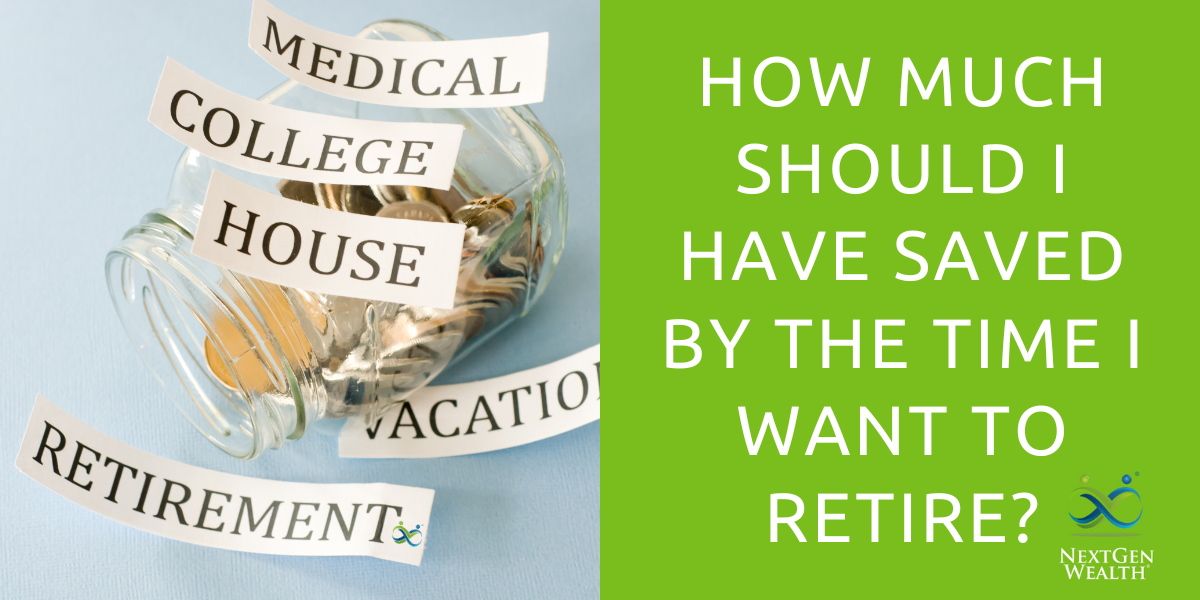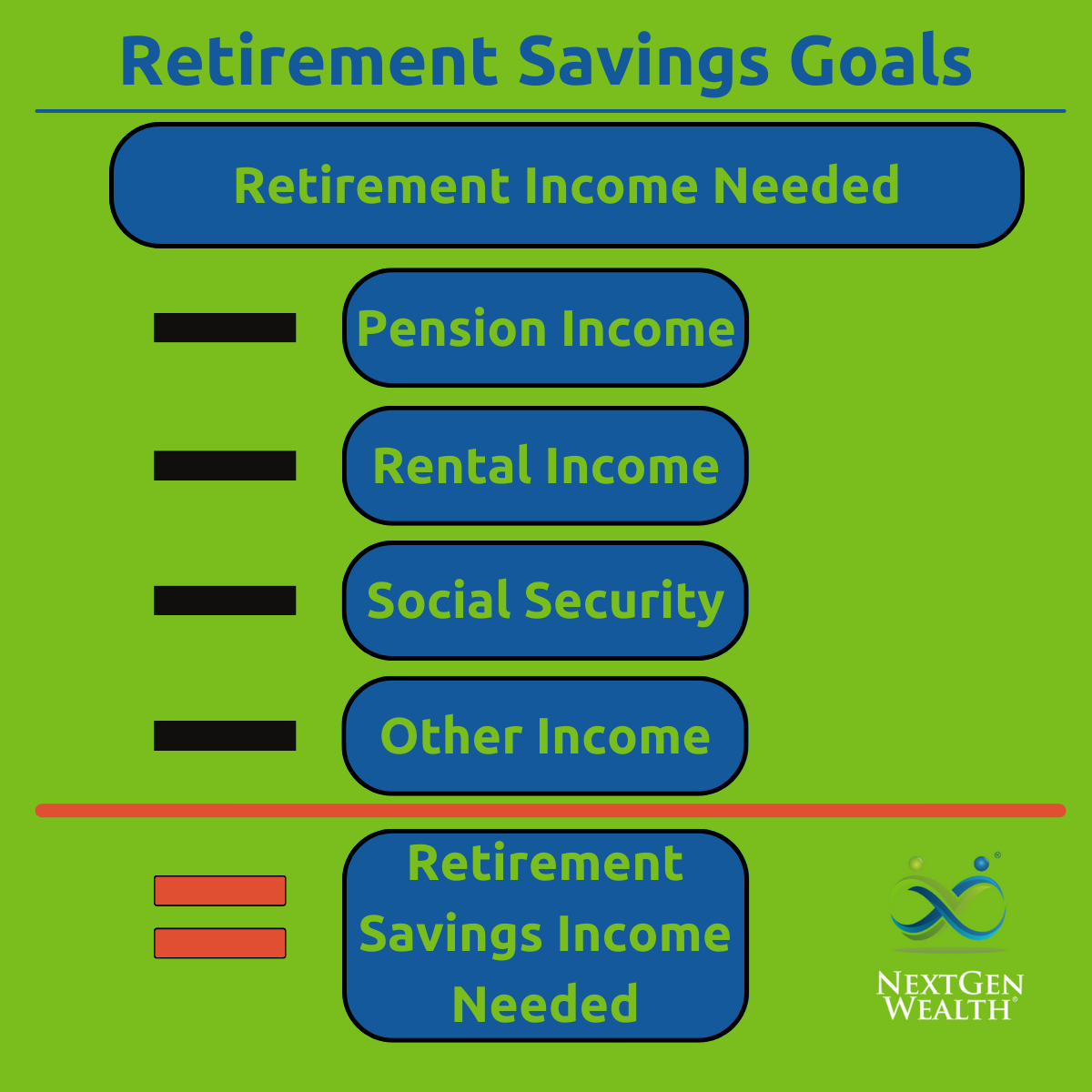How Much Should I Have Saved by the Time I Want to Retire?
 Do you know how much you should have saved to retire? What if you want to retire by 60 or 65 – maybe even sooner like 50? The answer depends on many variables in your life and potential income sources.
Do you know how much you should have saved to retire? What if you want to retire by 60 or 65 – maybe even sooner like 50? The answer depends on many variables in your life and potential income sources.
There’s not really a “magic number” like, “If you have __, you can retire at __ years old.” We first need to figure out what your anticipated income needs will be in retirement – we can call this educated guessing. Once we have our best estimate (guess) of your expenses, we can start to uncover how much you might need for retirement.
Estimating Retirement Income Needs
The first thing we need to nail down is what your anticipated retirement expenses will be. Keep in mind we said anticipated. You’re not really going to know until you get there – and things will continue to change over time.
Estimating Based on Current Expenses
Many folks will use some kind of ratio of your current expenses to estimate potential retirement expenses. Often, you might hear things like the 80% rule. This means you can estimate retirement spending to be roughly 80% of what you spend now.
However, this is a rule of thumb and doesn’t tell us anything about your specific needs. If you’re a long way from retirement, 10 years or more, this is a good starting point. There are expenses you won’t need to pay for any more like commuting to work, buying business attire, and other work-related expenses.
Once you get closer to retirement, you should be able to have a much clearer picture of what spending will be like.
Adjusting for Inflation
The other thing we need to consider is adjusting needs for inflation. Just because something costs $100 today, doesn’t mean it will cost $100 in 20 years. In fact, $100 in 2003 would be the equivalent of $168.32 just 20 years later in 2023.
Don’t be alarmed, this is something we anticipate and build into all our financial plans. Inflation will continue as the economy grows and expands. Just make sure you’re factoring this in when planning for retirement.
Unique Needs and Assets
As we mentioned earlier, your unique needs are going to play the biggest role in how much you need to save for retirement. Variables like if you have a paid off house, are caring for an adult child or parent, or make significant lifestyle changes will all be major factors.
For instance, if you plan to retire and move somewhere with a higher cost of living, you may need significantly more income than you do now. Conversely, if you move somewhere with a lower cost of living in retirement, you might be able to save less for retirement.
Evaluating Other Streams of Income
Let’s assume you have a solid estimate of your retirement income needs. Now you have to figure out where the needed income is going to come from. You need to tally up all your sources of income and then see what gaps remain.
Pension Income
If you’re going to have a pension, this will have a significant impact on your other income needs. There are still risks associated with a pension, but you should have some type of steady income you can rely on.
There are other pension considerations too. For example, if you have a military pension, there may be portions which are tax free. If you have a pension from being a teacher or rail worker, your Social Security may be affected.
Rental Income
If you have real estate income, this can impact how much you need to save as well. There may be some other factors such as depreciation, mixed-use property (if you stay in the properties), and risks with rising property taxes.
Regardless, rental properties can be a great way to build a more diverse stream of income in retirement. Some people even rely on rental income for a substantial portion of their retirement needs. If you don’t have a bunch of real estate, don’t worry, this is only one method of generating income.
Social Security
Depending on your work history, Social Security could be a significant portion of your retirement income. There are many folks who are skeptical of the long-term security of Social Security, but there’s no reason to completely discount Social Security. Social Security benefits may change over time, but there will be benefits for you into the foreseeable future.
Even though the Old-Age and Survivors Insurance (OASI) trust reserves are estimated to be depleted in 2034, benefits would continue at a reduced rate. We say all this to say, Social Security should not be your only source of income in retirement, but it should be a consideration.

Making Up the Difference with Investment Income
Once you’ve figured out your estimated retirement income needs and other sources of income, we can figure out how much you actually need to save. There are still variables to consider such as the safe withdrawal rate, guesses on returns, and inflation assumptions. These are “best guesses” which need to be revisited from time to time.
Safe Withdrawal Rate
You may have heard about the 4% safe withdrawal rate. This is just a rule of thumb and doesn’t apply to everyone. Ironically, the creator of the 4% safe withdrawal rate, Bill Bengen, was actually looking to find an alternative to other rules of thumb for safe withdrawal rates. In his research, he ended up creating the new rule of thumb.
However, there are still a myriad of factors which can change what a truly “safe” withdrawal rate is. Markets fluctuate, recessions happen, and sensational economic recoveries happen too. Depending on exactly when you retire, you might hit one or several of these events.
We can use 4% as a starting point, but this really isn’t a very exact estimate. The 4% withdrawal rate means you can pull out 4% of your whole portfolio per year as income and never run out of money. In other words, if you needed $80,000 of income, you would need $2 million in your retirement savings ($80,000/0.04 = $2,000,000).
However, if you already had pension income of $20,000 and rental income of $15,000, and Social Security benefits of $25,000 per year, you’d only need an additional $500,000 in retirement savings ($20,000/0.04 = $500,000). This could significantly reduce the amount of money you need to retire.
Guardrails
Although there are several versions of the guardrails method, the basic idea is to adjust your withdrawal rate over time. This allows you to pull out all the income you can while considering current economic conditions. For instance, if markets are up, you might be able to increase spending up to 4.5-5% but when markets are down, you might pull back a bit to 3-3.5%.
However, life isn’t always a smooth ride for spending or otherwise. If you’ve been planning a major remodel or other large purchase and the markets just happen to be down at the time, any set withdrawal percentage probably goes out the window. Once again, these are just guidelines – your life drives how you’ll adjust to current economic conditions.
Your Plan Will Need Adjustments Along the Way
Your spending plan and these rules of thumb aren’t always going to match up with real life. Changes happen and then we need to make matching adjustments to your financial plan.
The good thing is we are adaptable and there are many ways to shift things around. There’s a reason we call it planning, not deciding. We’re always in the present and looking toward the future.
Your retirement will look different if you retire in the middle of a recession versus a booming economy. However, both are possible. You can retire in the best and worst of times – you just need to have a plan.
You Still Need to Plan
Even if you had a perfect plan for your retirement two years ago, it’s completely obsolete now. The same will go for any plan we make today, but we still need to have a proper retirement plan. There’s always adjustments and having a professional help guide you through these changes (SECURE 2.0, etc.) is vital to your long-term success.
At NextGen Wealth, we help you craft a plan to retire with confidence and peace of mind despite what crazy things might be happening. We don’t have a magic wand to eliminate all the ups and downs, but we have been on this ride before. You deserve to have expert guidance as you enter retirement and continue your retirement journey.


